Metrics that Matter for Publishers: Mastering KPIs in Affiliate Marketing
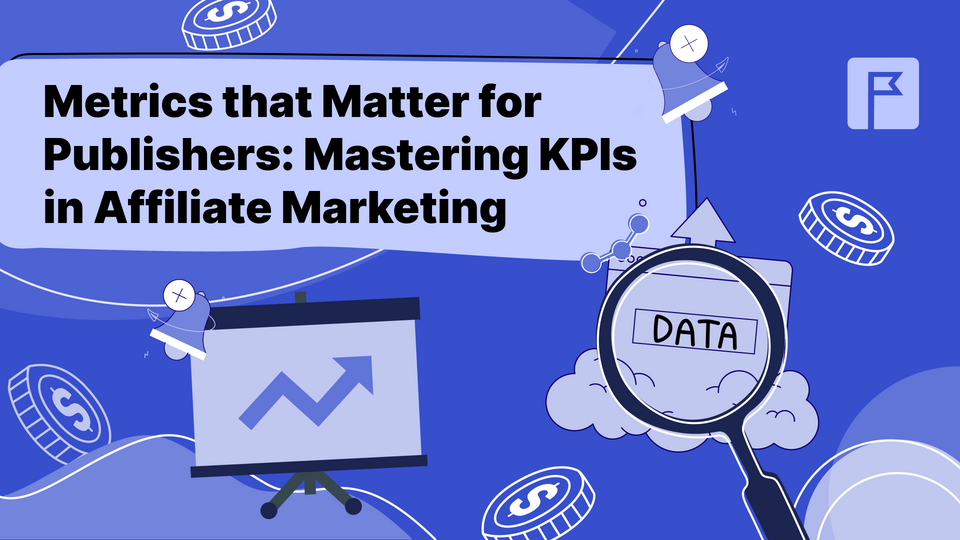
It's hard to disagree that reference points are needed in any business to effectively achieve a goal — and it's not just about financial performance. Not surprisingly, affiliate marketing is no exception. This digital marketing sphere has carved out a niche that benefits both creators and brands alike. Here, understanding the right Key Performance Indicators (KPIs) is crucial. This article sheds light on the essential KPIs for both affiliates and advertisers, offering insights to optimize your campaigns and drive unstoppable growth.
Understanding the core of affiliate marketing KPIs
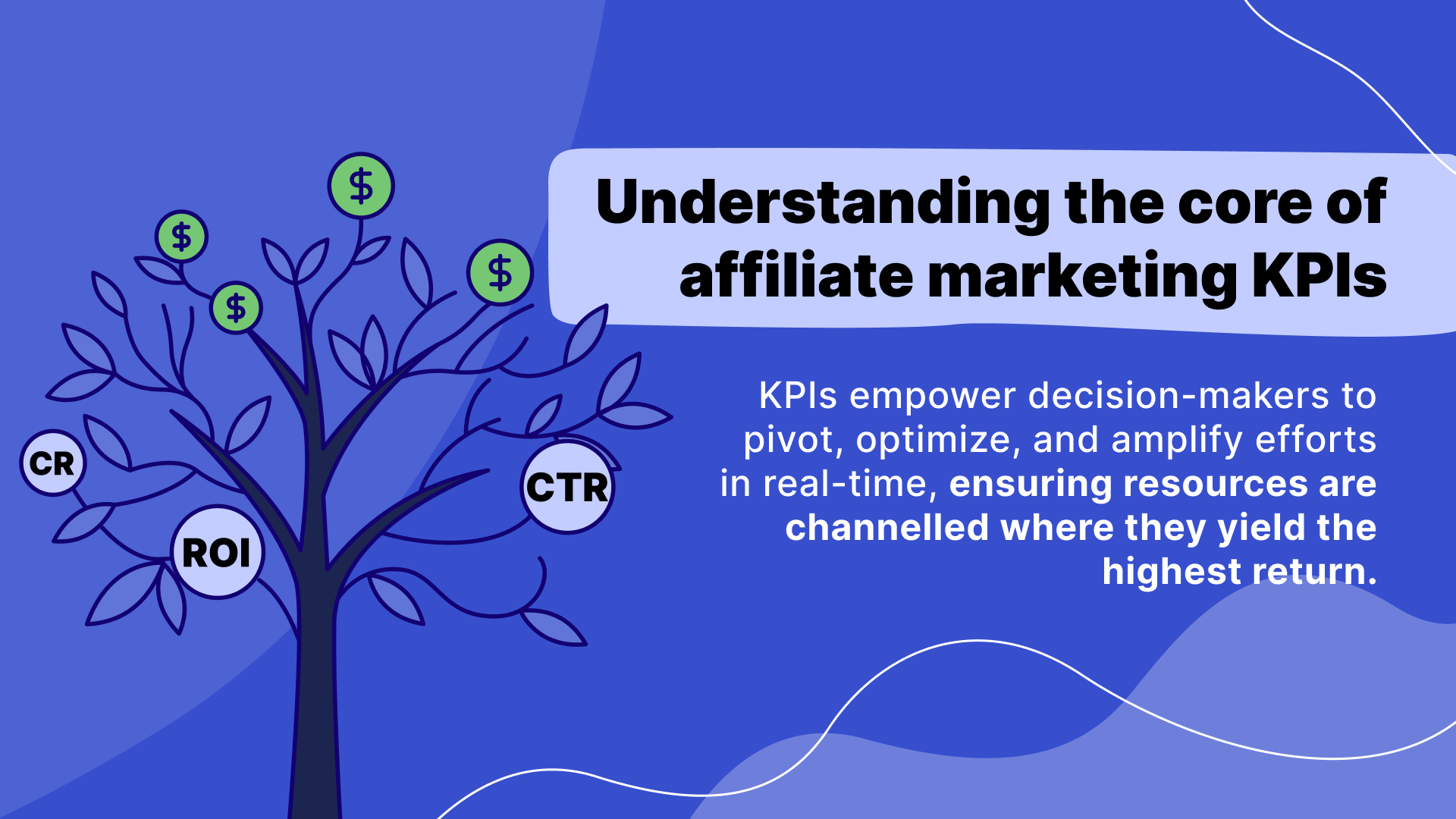
Plunging into the ins and outs of affiliate marketing, we encounter the critical role of Key Performance Indicators (KPIs) — the compasses that guide marketers towards their treasure: campaign success.
- In essence, KPIs serve as quantifiable metrics, illuminating the path to achieving strategic marketing objectives. They aren't just numbers; they are the narratives of progress, the milestones of growth.
- Specifically, in the realm of affiliate marketing, KPIs morph into specialized tools, finely tuned to echo the unique dynamics between affiliates and advertisers. They offer a granular view of performance, from click-through rates to conversions, shaping strategies with precision.
Understanding the importance of KPIs in measuring campaign success is akin to acknowledging the foundation of a successful venture. These metrics don't merely track progress; they empower decision-makers to pivot, optimize, and amplify efforts in real-time, ensuring resources are channelled where they yield the highest return.
Essential KPIs for publishers/affiliates
These select metrics serve as the starting point for strategies tailored specifically to those creating and curating content to drive sales — affiliates or so-called publishers. These KPIs are not just indicators but vital tools to navigate through the noise, ensuring that the efforts led directly to enhanced profitability.
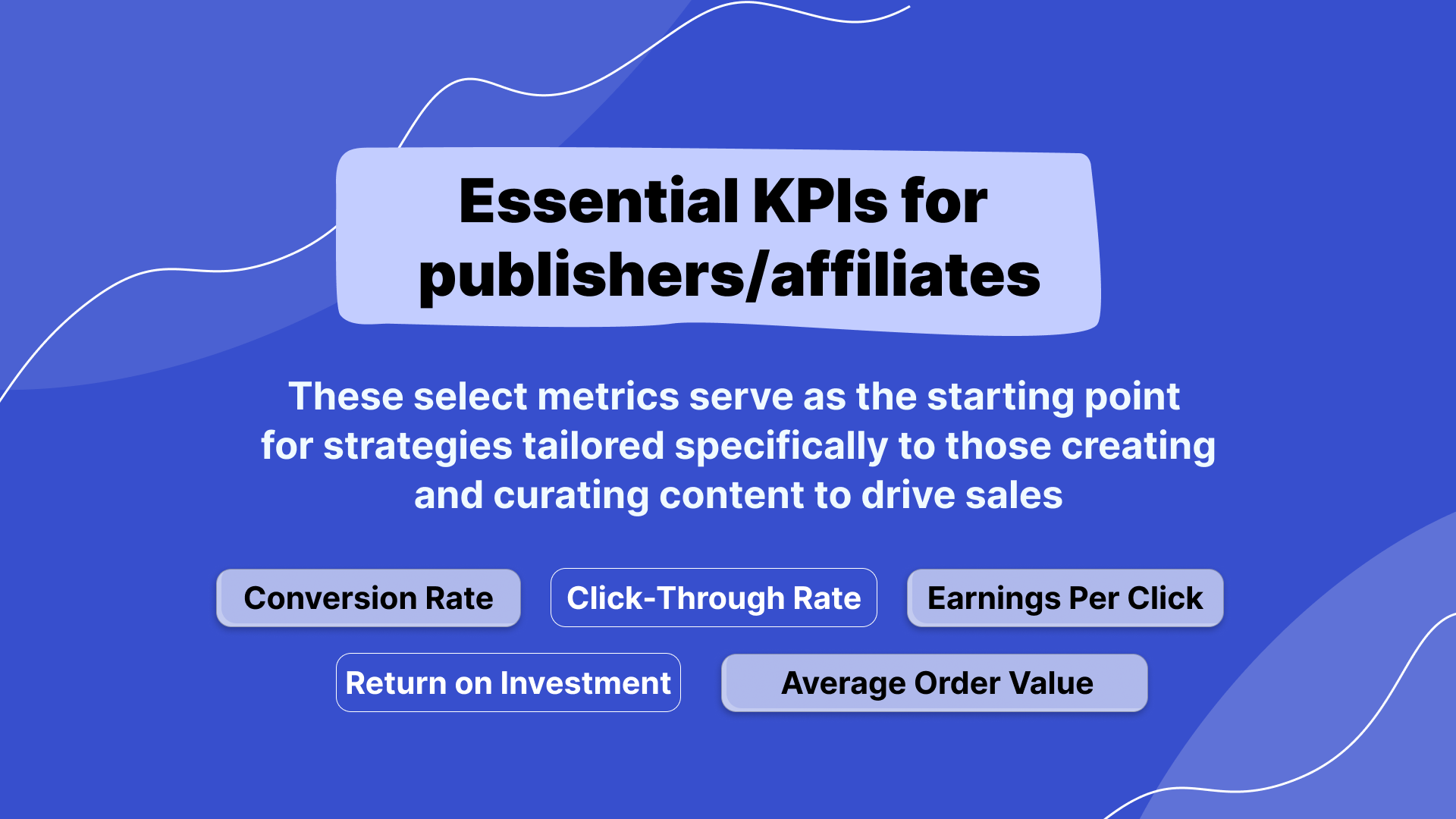
Conversion Rate (CR)
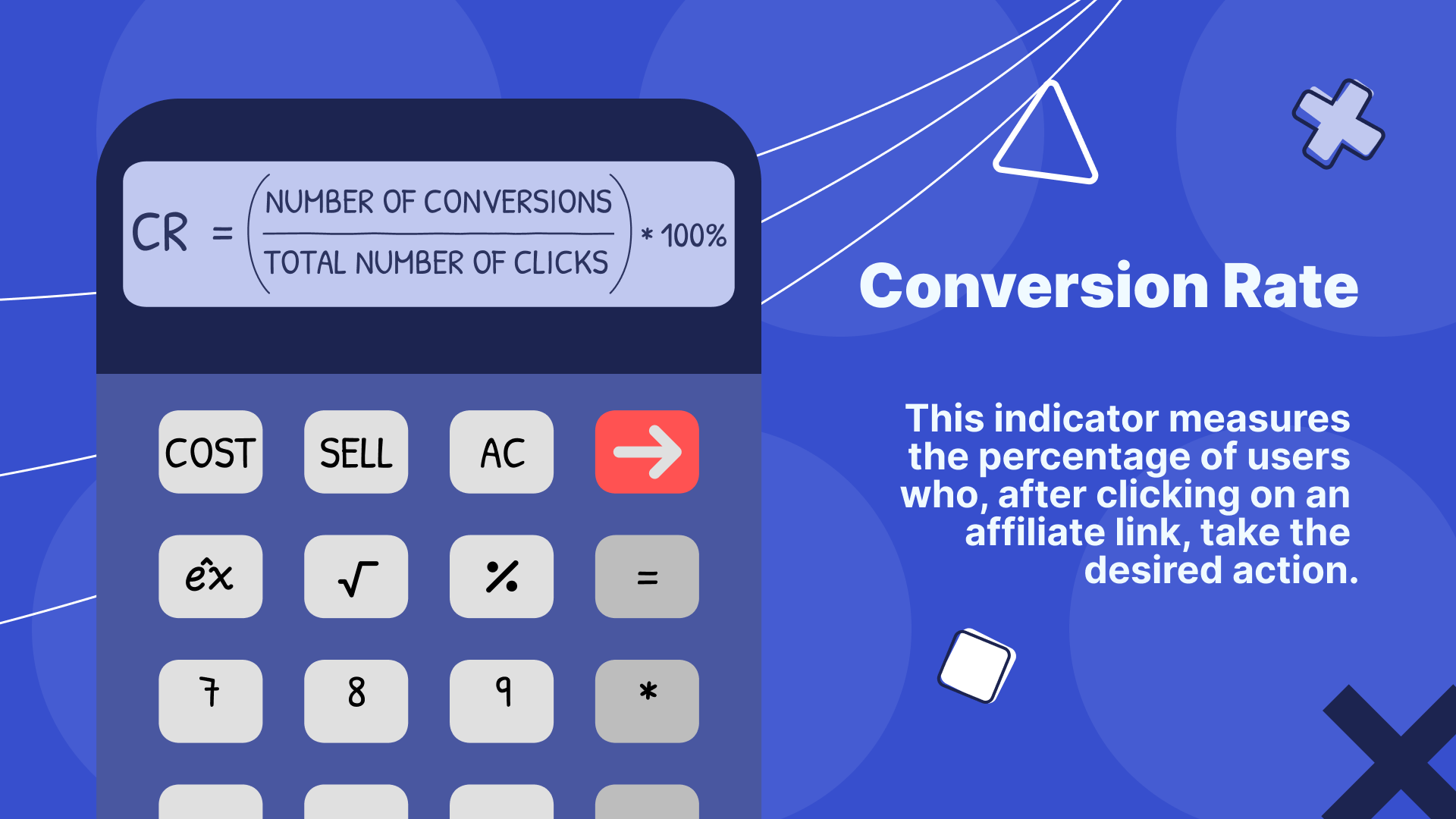
At the core of affiliate marketing for publishers lies the Conversion Rate, a metric that doesn't just track clicks, but follows the journey to action. This indicator measures the percentage of users who, after clicking on an affiliate link, take the desired action — be it making a purchase, signing up for a newsletter, or any other predefined goal.
- Why does it stand out in the crowded space of metrics? Simply put, the Conversion Rate bridges the gap between traffic and tangible success, providing a clear measure of how effectively affiliate content resonates with the audience and drives them to act.
Calculating this pivotal KPI is straightforward yet insightful: Take the number of conversions (actions completed) and divide it by the total number of visitors who clicked on the affiliate link, then multiply by 100 to get a percentage. This formula transforms raw data into a powerful gauge of affiliate performance, offering a crystal-clear perspective on the efficiency of marketing efforts.
A high Conversion Rate signifies that your content is not only reaching the right eyes, but also compelling enough to convert interest into action — marking the hallmark of a successful affiliate strategy.
Average Order Value (AOV)

The Average Order Value (AOV) shines as a crucial compass for affiliates and publishers navigating the vast seas of affiliate marketing. At its core, AOV measures the average dollar amount spent each time a customer completes a purchase through an affiliate link. It's not just a number; it's a mirror reflecting the purchasing power and behavior of your audience. Understanding AOV is pivotal for affiliates because it directly impacts revenue—higher order values mean more commission per transaction, making it essential for optimizing promotional strategies and selecting the right products or services to endorse.
- Why does AOV command such importance? It offers a clear lens into the effectiveness of your marketing efforts, helping to tailor strategies that encourage higher spending. This insight enables affiliates to focus on promoting products that not only convert but also bring in higher earnings per sale.
Calculating AOV is as simple as it is insightful: divide the total revenue generated from affiliate-linked sales by the number of orders. The formula appears as follows:
Click-Through Rate (CTR)

In the digital tapestry of affiliate marketing, the Click-Through Rate (CTR) stands out as a critical thread for affiliates and publishers, measuring the heartbeat of audience engagement. This indispensable metric gauges the ratio of users who click on an affiliate link to the number of total viewers that have seen the link. CTR isn't just a number — it's a pulse, a direct reflection of how compelling your content is and how effectively it motivates your audience to take action. Its importance cannot be overstated; a high CTR indicates that your marketing strategies are resonating, capturing attention, and successfully encouraging clicks. Conversely, a low CTR signals a need to reassess your approach, perhaps by refining your content or reevaluating the placement of your affiliate links.
- Why does CTR hold such a pivotal role? It acts as a litmus test for your content's relevance and appeal, directly influencing the effectiveness of your affiliate campaigns. High click-through rates open the door to higher conversion opportunities, driving up potential earnings and enhancing the visibility of the products or services you're promoting.
Calculating CTR is both straightforward and enlightening: divide the number of clicks your affiliate link receives by the number of times your link is displayed, then multiply by 100 to convert it into a percentage. The formula breaks down into:
This simple calculation provides invaluable insights, empowering affiliates to fine-tune their strategies, boost engagement, and ultimately, drive more successful conversions.
Earnings Per Click (EPC)
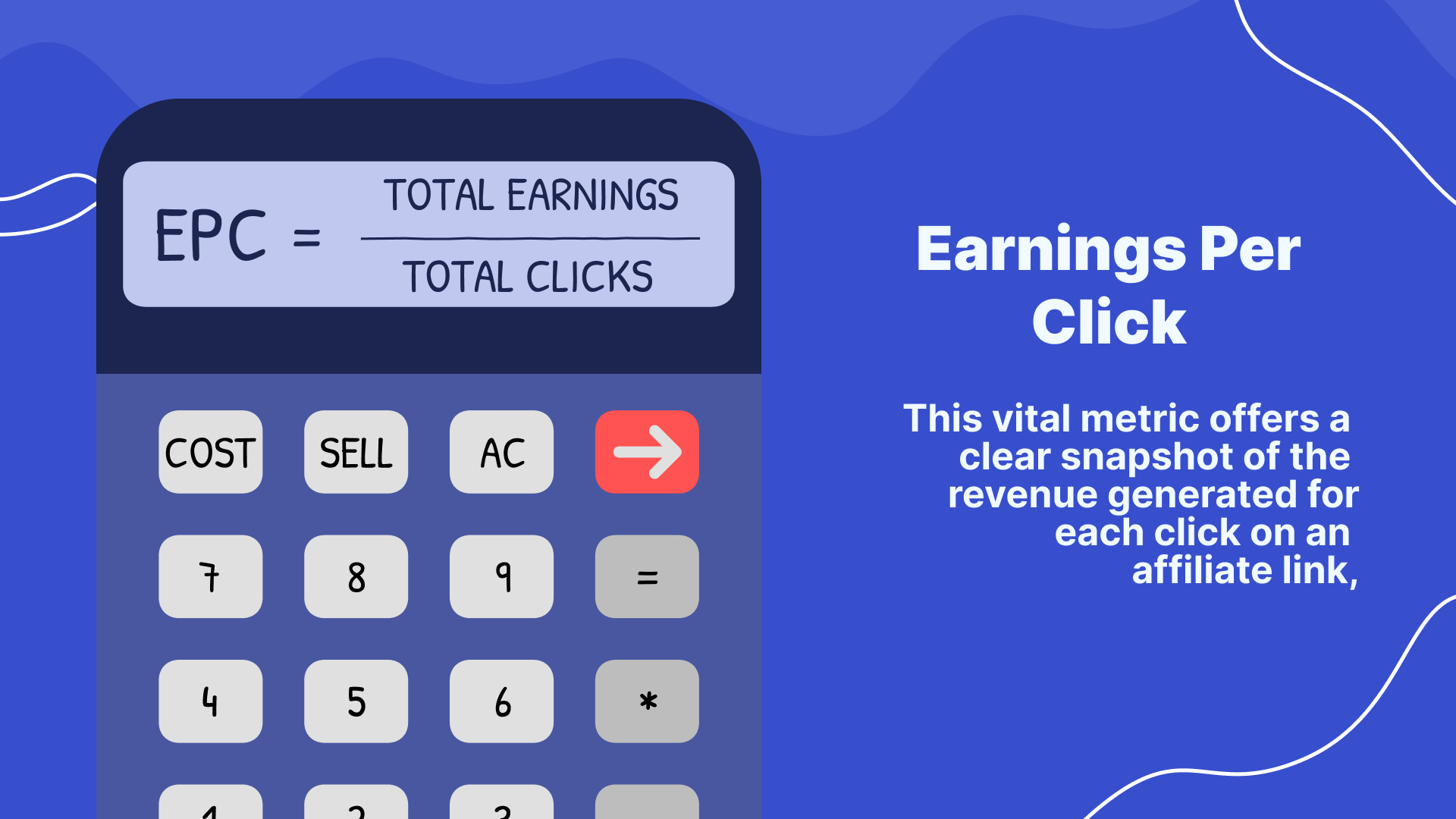
Earnings Per Click (EPC) stands as a lighthouse for affiliates. This vital metric offers a clear snapshot of the revenue generated for each click on an affiliate link, serving as a barometer for the financial health of your marketing efforts. EPC goes beyond mere click counts and conversion rates; it ties the effectiveness of your affiliate strategies directly to tangible earnings.
- Why is EPC so crucial? It levels the playing field, allowing affiliates to compare the profitability of different campaigns or products, regardless of their size or scope. A high EPC signals that you're on the right track, creating compelling content and selecting affiliate offers that resonate with your audience and yield substantial returns.
The importance of EPC extends to its role in strategic decision-making. It helps affiliates identify the most lucrative partnerships and promotions, focusing their efforts where the financial rewards are greatest. Calculating EPC is straightforward but revealing: divide the total earnings from your affiliate promotions by the total number of clicks those promotions received. The formula is elegantly simple:
Return on Investment (ROI)
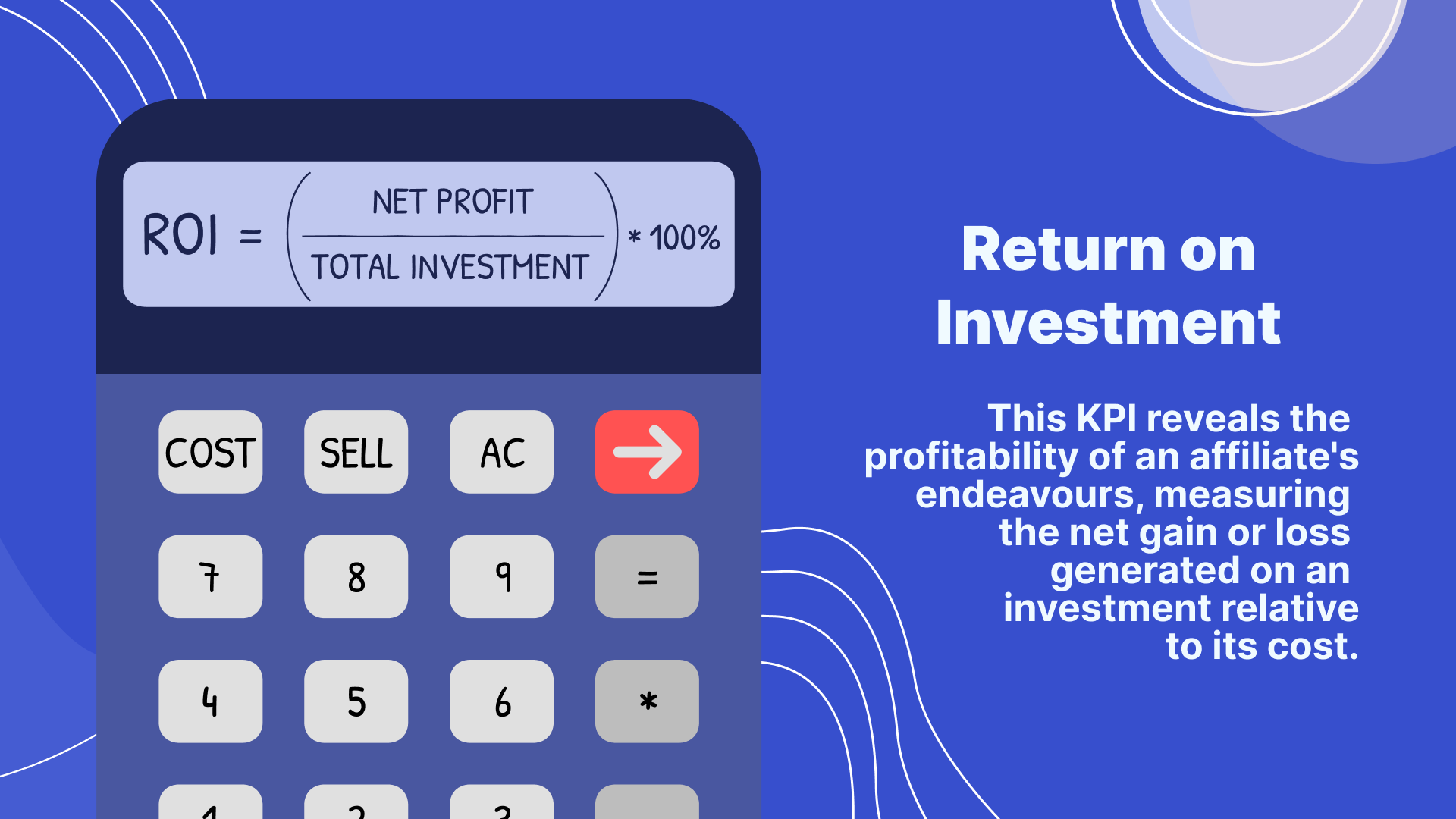
In the intricate dance of affiliate marketing, Return on Investment (ROI) serves as the grand finale, encapsulating the essence of success in financial terms. This central KPI reveals the profitability of an affiliate's endeavours, measuring the net gain or loss generated on an investment relative to its cost. Far from being just another statistic, ROI is the storyteller of your marketing saga, narrating the tale of your financial triumphs and challenges. It holds a magnifying glass to the effectiveness of your strategies, spotlighting the efficiency of your spending and the wisdom of your campaign choices.
- Why is ROI revered among affiliates and publishers? It offers a panoramic view of campaign performance, equipping you with the insights to make informed decisions. A robust ROI indicates a well-oiled marketing machine, where investments are recuperated and multiplied, signalling a healthy and sustainable affiliate operation.
Calculating ROI involves a straightforward formula that packs a punch of clarity:
Final thoughts
Mastering the art of KPI tracking in affiliate marketing is not just about number-crunching; it's about transforming insights into action. By focusing on the right metrics, both affiliates and advertisers can forge campaigns that are not only profitable but also sustainable in the long run. Embrace these KPIs, and watch your affiliate marketing efforts reach new heights.
FAQs: KPIs in affiliate marketing for publishers
What are KPIs in affiliate marketing?
Key Performance Indicators (KPIs) in affiliate marketing are measurable values that indicate the performance and success of affiliate campaigns. They help affiliates and advertisers track progress towards their goals, such as sales, clicks, conversions, and overall campaign effectiveness.
Why are KPIs important for affiliates?
For affiliates, KPIs are crucial for understanding how well their promotional efforts are converting visitors into actions (like sales or sign-ups). They help in identifying successful strategies, optimizing campaigns for better performance, and ultimately increasing earnings.
Can Earnings Per Click (EPC) vary between different affiliate programs?
Yes, EPC can vary significantly between different affiliate programs due to factors like the target audience, product type, commission structure, and the effectiveness of promotional content. Affiliates should compare EPCs to identify the most profitable programs.
How often should I review my affiliate marketing KPIs?
Reviewing KPIs should be an ongoing process, with frequent checks for short-term campaigns and at least monthly reviews for long-term strategies. This regular analysis allows for timely adjustments to optimize performance and maximize returns.
